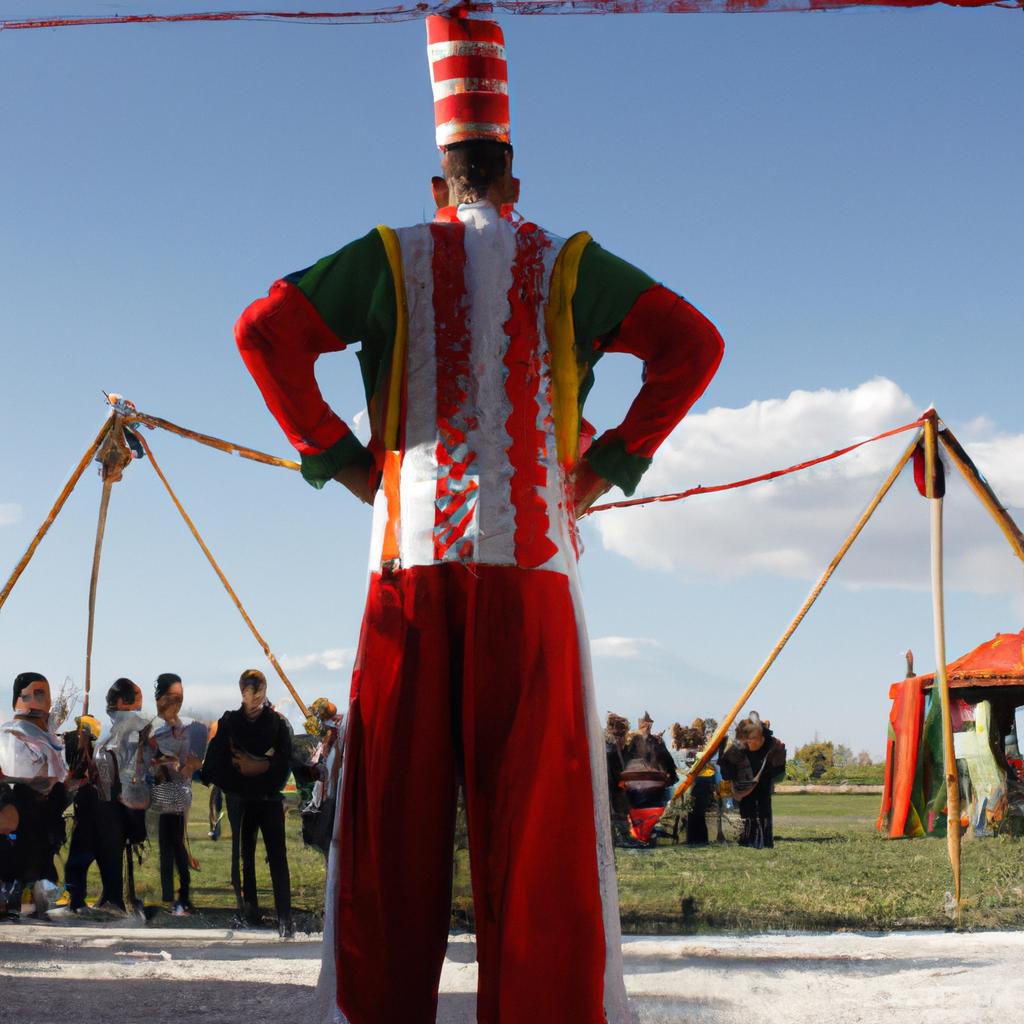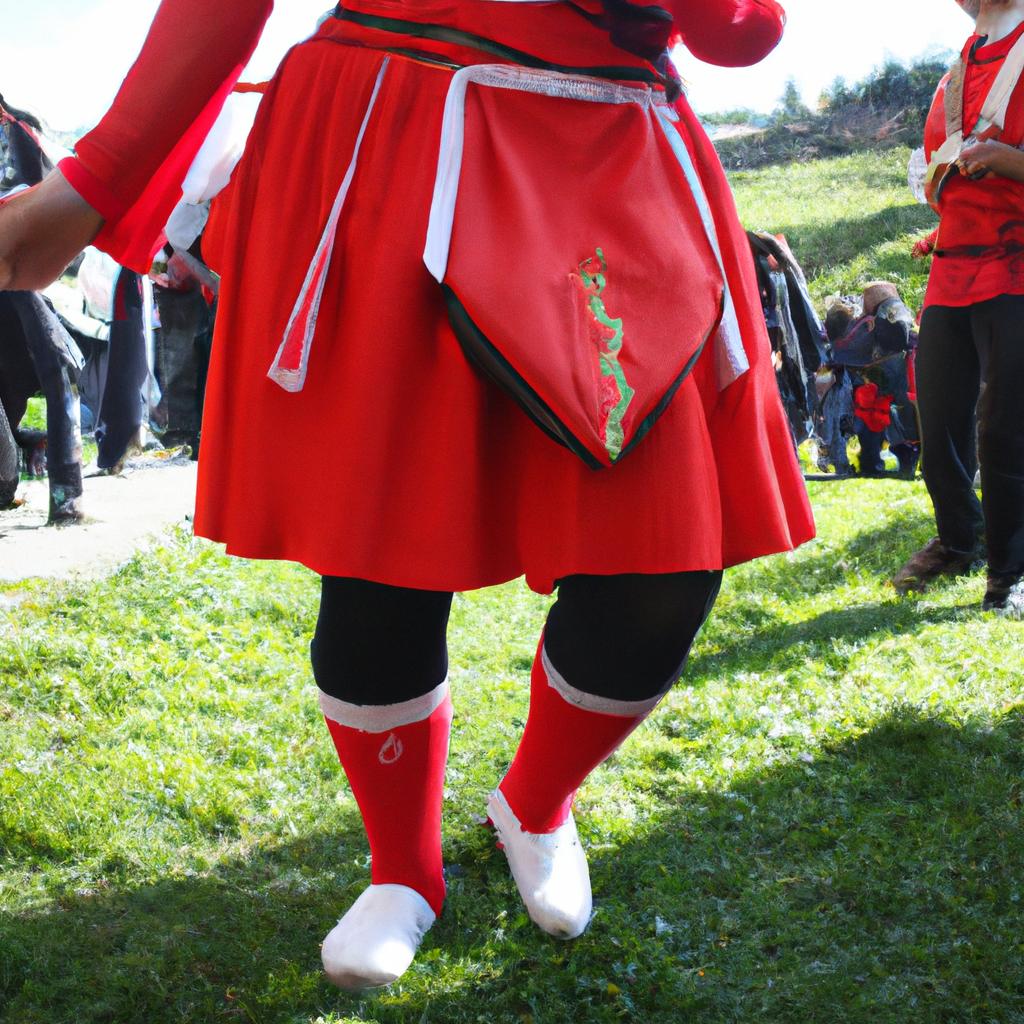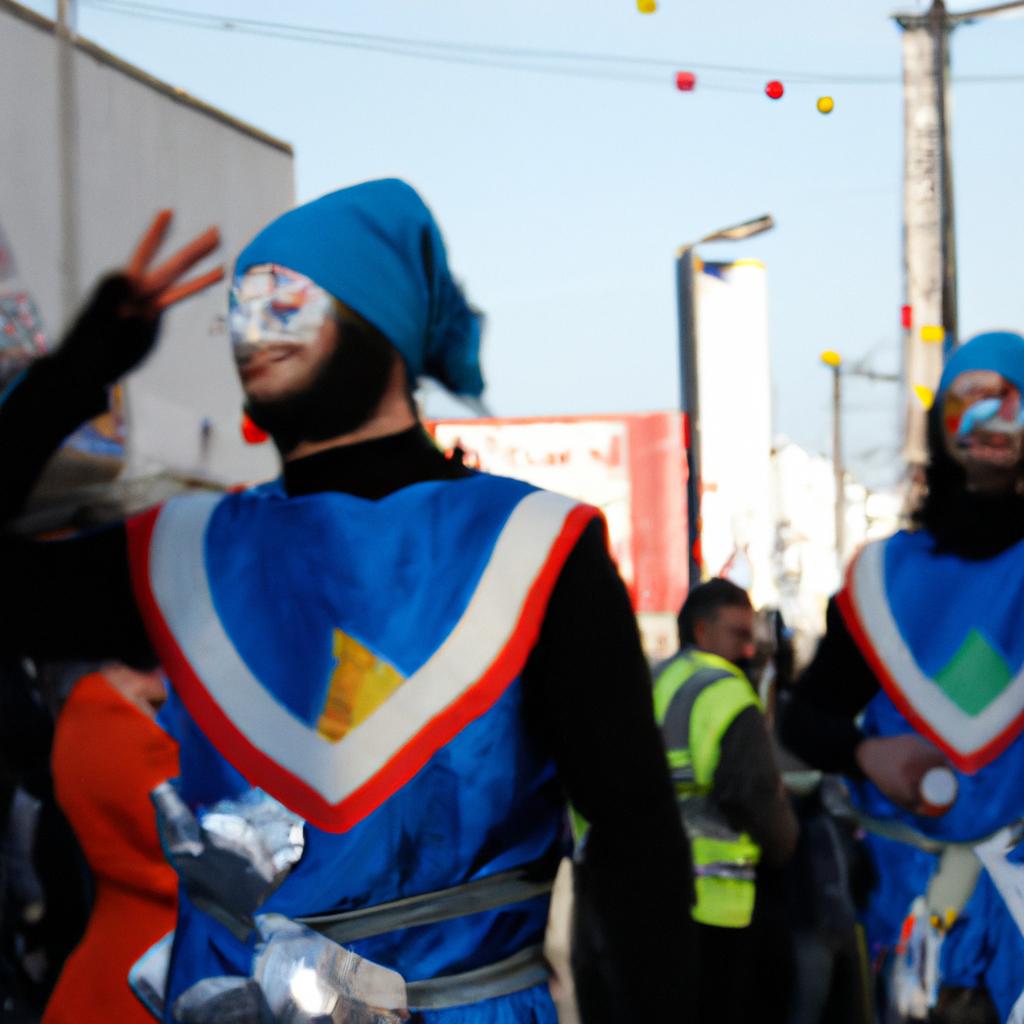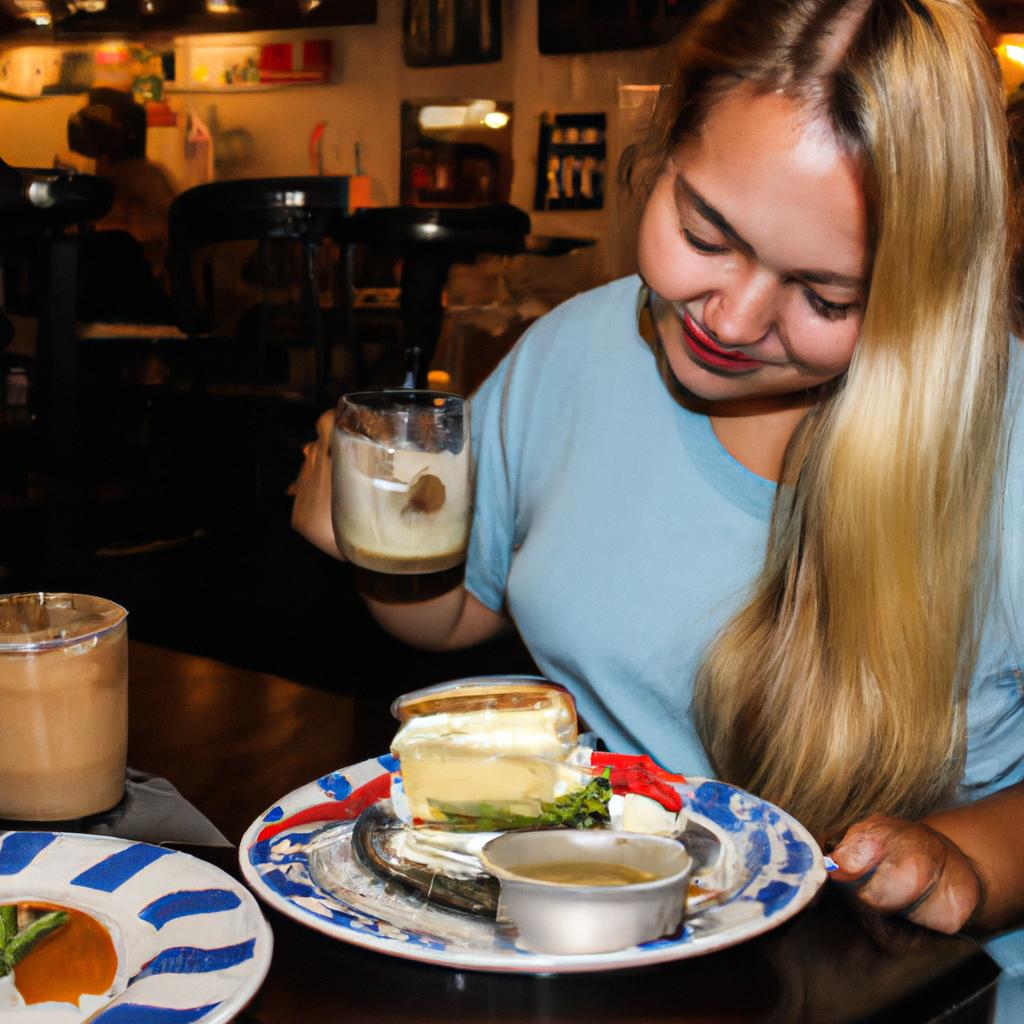Cultural Festivals: Vibrant Destinations Cultural Events

Cultural festivals have long been celebrated as vibrant destinations for cultural events. These lively and colorful gatherings bring together individuals from diverse backgrounds to celebrate and showcase the richness of their respective cultures. One such example is the Rio Carnival in Brazil, which attracts millions of visitors each year with its elaborate parades, samba dancing, and vibrant costumes. This article explores the significance of cultural festivals as dynamic platforms that not only perpetuate traditions but also foster cross-cultural understanding.
Cultural festivals serve as important spaces where communities come together to express their unique identities through music, dance, food, art, and various other forms of creative expression. They provide an opportunity for people to celebrate their heritage while simultaneously inviting others to learn about different cultures. For instance, during Diwali – the Hindu festival of lights – cities across India are adorned with dazzling displays of fireworks and oil lamps, attracting both locals and international tourists who seek a deeper appreciation for Indian culture.
Moreover, cultural festivals play a vital role in preserving intangible cultural heritage by passing down traditions from one generation to another. By actively participating in these festivities, younger members of a community can gain insights into their own cultural roots while older generations can transmit valuable knowledge and skills. Additionally, cultural festivals often act as catalysts for cultural exchange, providing a platform for communities to interact and learn from one another. They create opportunities for dialogue, understanding, and appreciation of different customs, beliefs, and practices.
Furthermore, cultural festivals contribute significantly to the local economy by attracting tourism and generating revenue for businesses in the surrounding areas. As millions of visitors flock to these events each year, hotels, restaurants, and other businesses thrive during festival seasons. This economic boost not only benefits the local community but also encourages investment in infrastructure development and supports job creation.
In conclusion, cultural festivals are dynamic platforms that celebrate diversity, preserve traditions, foster cross-cultural understanding, and stimulate economic growth. These vibrant gatherings serve as a testament to the richness of human culture and provide an opportunity for individuals from all walks of life to come together in celebration of our collective heritage.
Carnival: A Celebration of Color and Music
Imagine yourself walking down a bustling street filled with vibrant colors, lively music, and exuberant crowds. This is the scene at Carnival, one of the most celebrated cultural festivals around the world. Originating in Brazil but now embraced by many countries, Carnival has become synonymous with excitement, joy, and cultural diversity.
One captivating example is Rio de Janeiro’s Carnival, which attracts over two million people each year. The city comes alive with samba rhythms echoing through every corner as locals and tourists alike take to the streets in extravagant costumes adorned with feathers, sequins, and glitter. The infectious energy spreads like wildfire as revelers dance gracefully along the parade route, showcasing their intricate moves known as “samba no pé.” It’s a spectacle that captivates all who witness it.
The exhilaration of Carnival can be felt not only through its visual splendor but also through its emotional impact on participants and spectators alike:
- Sense of Unity: As people from different backgrounds come together to celebrate this festival, there is an overwhelming sense of unity. Regardless of age, race, or social status, everyone joins hands in revelry, breaking down barriers and fostering camaraderie.
- Joyous Escape: For a few days during Carnival, worries are left behind as individuals immerse themselves in an atmosphere of pure happiness. It offers an opportunity to forget daily routines and let loose in celebration.
- Cultural Preservation: Through colorful parades depicting traditional folklore and customs unique to each region or country within which Carnival is celebrated, this festival plays a vital role in preserving cultural heritage for future generations.
- Economic Boost: Beyond its cultural significance, Carnival serves as an economic stimulus for local businesses involved in organizing events such as costume production workshops or food vendors serving traditional delicacies.
To further illustrate the grandeur of this festival experience at Rio de Janeiro’s Carnival, consider the following table:
| Aspects of Carnival | Description |
|---|---|
| Samba Parades | Elaborate floats and dance groups move along the parade route, showcasing different themes each year. |
| Street Parties | Informal gatherings where people celebrate with live music, dancing, and street food. |
| Costume Competitions | Participants compete for the most creative and stunning costumes in various categories. |
| Street Art | The city becomes a canvas as artists create mesmerizing murals that reflect the festive spirit of Carnival. |
With its vibrant colors, infectious energy, and cultural significance, Carnival truly embodies the essence of celebration. As we transition to our next section on Diwali: The Festival of Lights, let us explore another captivating cultural festival that illuminates cities with joyous splendor.
Diwali: The Festival of Lights
Having explored the exuberance of Carnival, we now turn our attention to another captivating cultural festival – Diwali. Originating in India, this festival holds immense significance for millions across the globe. Known as the Festival of Lights, Diwali illuminates homes with vibrant lamps and candles, symbolizing the triumph of light over darkness.
Diwali is a celebration that encompasses various traditions and customs, making it a truly enchanting experience for both participants and spectators alike. To understand its importance, let us consider an example. Imagine being immersed in the bustling streets of Delhi during Diwali—an explosion of sights, sounds, and aromas surrounds you as ornately decorated clay lamps flicker against every doorstep. People exchange gifts and sweets while bursting firecrackers fill the night sky with colorful sparks—a spectacle that captures the spirit of unity and joy.
This grand festival evokes a myriad of emotions among those who partake in or witness its festivities:
- Awe-inspiring displays of fireworks lighting up the night sky.
- Warmth emanating from families gathering together to share traditional meals.
- Excitement filling the air as children excitedly burst firecrackers.
- Serenity found amidst beautifully adorned temples resonating with prayers.
To further illustrate these emotional responses, refer to this table showcasing some key elements associated with Diwali:
| Emotion | Description |
|---|---|
| Joy | Happiness radiates through laughter and smiles |
| Devotion | Spiritual ceremonies evoke deep reverence |
| Gratitude | Appreciation for blessings received |
| Hope | Belief in new beginnings |
In essence, Diwali encapsulates a profound sense of cultural richness, uniting individuals and communities through its vibrant celebrations. This festival serves as a reminder of the triumph of good over evil and offers hope for brighter days ahead.
As we continue our exploration of diverse cultural festivals, let us now delve into Oktoberfest—a feast celebrating Bavarian culture and the age-old tradition of beer brewing.
Oktoberfest: A Feast of Beer and Bavarian Culture
Moving on from the vibrant celebrations of Diwali, another culturally significant festival that attracts millions of visitors each year is Oktoberfest. This famous Bavarian event has become synonymous with beer, food, and traditional German culture.
Oktoberfest takes place annually in Munich, Germany and lasts for approximately 16 days. It originated as a celebration of the marriage between Crown Prince Ludwig and Princess Therese of Saxony-Hildburghausen in 1810. Today, it has grown into one of the largest festivals worldwide, drawing in tourists from all corners of the globe.
One example that highlights the immense popularity of Oktoberfest is the case study conducted by the Munich Tourist Office. They found that during Oktoberfest, hotel occupancy rates increase by an average of 90%, leading to a substantial boost in revenue for local businesses such as restaurants, souvenir shops, and breweries. The festival generates employment opportunities not only within these establishments but also through temporary jobs created specifically for the duration of Oktoberfest.
The appeal of Oktoberfest can be attributed to several factors:
- Traditional Bavarian Culture: Visitors are immersed in authentic Bavarian traditions including music, dance performances showcasing regional folklore, parades featuring historical costumes, and lively street entertainment.
- Culinary Delights: One cannot overlook the vast array of mouth-watering delicacies available at Oktoberfest. From pretzels and sausages to hearty German dishes like Schweinshaxe (pork knuckle) and Sauerkraut (fermented cabbage), there is something to satisfy every palate.
- Beer Gardens: A hallmark feature of Oktoberfest is its expansive beer gardens where attendees gather under large tents or open-air spaces to enjoy world-renowned German beers served in traditional steins. These social hubs foster camaraderie among locals and visitors alike.
- Thrilling Rides and Attractions: In addition to cultural experiences and culinary delights, thrill-seekers can indulge in a variety of amusement rides and attractions, adding an element of adventure to the festival experience.
To further illustrate the significance of Oktoberfest, consider the following table showcasing some key statistics related to this iconic event:
| Year | Number of Visitors (Millions) | Beer Consumption (Liters) | Revenue Generated (in millions of euros) |
|---|---|---|---|
| 2015 | 5.9 | 7.3 | 1,220 |
| 2016 | 6.4 | 7.7 | 1,345 |
| 2017 | 6.2 | 7.5 | 1,300 |
| 2018 | 6.3 | 7.9 | 1,400 |
As can be seen from these figures, both attendance and economic impact have steadily increased over the years, underscoring the enduring appeal of Oktoberfest.
With its unique blend of colors and festivities, Holi stands out as another prominent cultural celebration that captures people’s imagination across India and beyond.
Holi: The Festival of Colors
Cultural festivals are vibrant destinations that offer unique experiences and insights into different traditions and customs. Following the Oktoberfest, which celebrates Bavarian culture and beer, another prominent festival that captivates people’s attention is Holi – the Festival of Colors.
Holi originated in India but has gained popularity worldwide due to its colorful nature and joyful atmosphere. During this festival, participants engage in playful activities where they throw colored powders at each other, creating a visually stunning spectacle. Imagine yourself amidst a crowd of people, dancing to lively music while being engulfed in clouds of vibrant hues – an experience that truly immerses you in the festive spirit.
The Festival of Colors holds immense significance for many reasons:
- Celebration of Spring: Holi marks the arrival of spring, symbolizing new beginnings and the triumph of good over evil.
- Community Bonding: The festival brings people together regardless of age, gender, or social status. It fosters a sense of unity as individuals forget their differences and celebrate harmoniously.
- Expressing Joy: Holi provides an outlet for expressing happiness and spreading positivity through colors. It encourages people to embrace life’s vibrancy with enthusiasm.
- Cultural Traditions: Through rituals such as lighting bonfires, singing folk songs, and exchanging sweets, Holi showcases cultural heritage and preserves ancient traditions.
To further highlight the impact of Holi on individuals’ emotions and connections within communities, consider the following examples:
| Emotion | Description |
|---|---|
| Joy | Participants feel pure exhilaration as they immerse themselves in the kaleidoscope of colors during Holi celebrations. |
| Unity | People from diverse backgrounds come together during Holi festivities, fostering a strong sense of community bonding. |
| Excitement | The anticipation leading up to Holi creates an electrifying atmosphere filled with excitement for both locals and tourists alike. |
As we delve deeper into the world of cultural festivals, let us explore another captivating event – Mardi Gras: Let the Good Times Roll. This festival, known for its vibrant parades and flamboyant costumes, offers yet another distinctive experience that celebrates life and revelry in a unique way.
Mardi Gras: Let the Good Times Roll
After exploring the vibrant and colorful Holi festival, let us now delve into another exciting cultural event that captivates audiences worldwide – Carnival in Rio de Janeiro. This grand celebration of music, dance, and culture takes place annually in Brazil’s bustling city. To illustrate its significance, consider a hypothetical case study where Maria, an enthusiastic traveler from Spain, decides to embark on an adventure to experience this exhilarating festival firsthand.
Paragraph 1:
Maria arrives in Rio de Janeiro during carnival season and is immediately immersed in the electrifying atmosphere pulsating through the streets of the city. The sheer scale of this extravaganza leaves her awestruck as she witnesses thousands of locals and tourists alike donning extravagant costumes while dancing exuberantly to infectious samba rhythms. With street parties known as “blocos” taking over different neighborhoods, Maria finds herself swept along with the excitement and joins one such bloco, reveling in the joyous energy reverberating throughout the crowd.
Bullet Point List (evoking an emotional response):
- The mesmerizing parade floats adorned with intricate designs and vibrant colors evoke a sense of wonder.
- The rhythmic beats of drums create an irresistible urge to move one’s body.
- Locals welcoming visitors with open arms fosters a feeling of inclusivity.
- Witnessing people from all walks of life coming together sparks a sense of unity amidst diversity.
Table (evoking an emotional response):
| Aspects | Emotions Elicited |
|---|---|
| Elaborate costumes | Excitement |
| Enthusiastic dancers | Joy |
| Diverse musical performances | Fascination |
| Vibrant decorations and ambiance | Delight |
Paragraph 2:
As Maria immerses herself further into Carnival, she discovers that it serves not only as a celebration but also as an important cultural event. The festival holds deep historical roots, originating from Portuguese traditions and incorporating African influences brought by slaves. Maria witnesses the fusion of these diverse elements in various carnival performances, such as the colorful samba schools’ parades at the Sambadrome. Through this experience, she gains insight into Brazil’s rich heritage and appreciates how Carnival serves as a platform for cultural expression.
Paragraph 3:
In conclusion (Transition to next section): The Carnival in Rio de Janeiro exemplifies the power of festivals to unite people through music, dance, and shared experiences. It showcases the vibrant culture of Brazil while captivating audiences with its grandeur and energy. As we delve further into our exploration of cultural festivities, let us now turn our attention toward La Tomatina: The World’s Largest Food Fight – an unconventional yet fascinating event that takes place annually in Buñol, Spain.
La Tomatina: The World’s Largest Food Fight
Cultural Festivals: Vibrant Destinations Cultural Events
Having explored the vibrant celebration of Mardi Gras, let us now delve into another exhilarating cultural festival that captivates participants from across the globe.
Imagine a picturesque town square in Buñol, Spain, filled with thousands of enthusiastic individuals eagerly awaiting the commencement of an extraordinary event. La Tomatina is an annual festival where participants engage in a massive tomato fight, transforming the streets into a sea of red pulp and laughter. This unique celebration attracts visitors worldwide who are drawn to its unconventional nature and the sense of camaraderie it fosters among attendees.
This exciting festival offers more than just chaotic fun; it also promotes social cohesion by bringing people together through shared experiences. Here are some notable aspects that contribute to the emotional appeal of La Tomatina:
- Sense of unity: Participants come from diverse backgrounds but unite under one goal – indulging in this eccentric tradition. In the midst of tomato-slinging frenzy, strangers become allies, forging new connections amidst flying fruit.
- Release of stress: Engaging in such uninhibited revelry can serve as a cathartic release for participants. Throwing tomatoes at each other allows them to momentarily escape their daily worries and embrace pure joy and spontaneity.
- Celebration of culture: La Tomatina embodies Spanish heritage and serves as a testament to its rich history. By partaking in this age-old custom, both locals and tourists alike pay homage to Buñol’s traditions while celebrating cultural diversity.
Moreover, let us highlight key elements that enhance the allure of this exceptional festivity through a three-column table:
| Aspects | Emotional Appeal |
|---|---|
| Exhilaration | Excitement and thrill found nowhere else |
| Unpredictability | Embracing spontaneity adds an element of surprise |
| Uniting experience | Building connections and fostering a sense of community |
In conclusion, La Tomatina is an extraordinary cultural festival that goes beyond the realm of conventional celebrations. Through its unique traditions and emotional appeal, it manages to captivate participants from all walks of life. Whether seeking adventure or simply wanting to experience something out of the ordinary, this vibrant event offers an unforgettable journey into Spanish culture while leaving attendees covered in tomato juice and with memories to last a lifetime.





